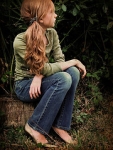Hair Care For Children

Children’s hair is normally in beautiful condition and is best cut and styled simply. Children are very precious for their mothers, so it makes sense that you will want the best for them. Although some babies are born totally bald some babies are born with a soft, fuzzy head of hair that is frequently light in colour. This hair lasts for at least two to three months after which the hair falls off, and new hair grows in its place. The new hair is generally much fuller than the newborn hair and tends to grow in a set pattern. Your baby may have very little hair but it is important to make shampooing a pleasant experience for your child. But most babies and children hate it when their hair is being shampooed. By bringing about good habits early in life, the child will be more likely to practice proper hair care in the future. Caring for your child’s hair is very important. Their hair is usually very fine and are easily tangible, and kids do need special products and it is a known fact that kids hate it when you touch their hair.
Here are some tips which will make hair care for your child easier for you as well as your child.

Determine Your Child’s Hair Type:
Before you take care of your child’s hair, determine what hair type he or she has. If the hair looks tangled, oily and sad at the end of the day, they probably have fine oily hair. If the hair is frizzy and coarse, they probably have dry, curly hair. Observe your child’s hair over the weeks and then decide what sort of products are suitable to use for them.
Hair Care Shampoo:
Basically, kids do not need to have their hair to be shampooed on an every day basis as the hair is fine. You should shampoo their hair only when you feel it is required. For instance, if the child has been playing around in mud or with other children, or you find that the scalp is oily. Wash the hair carefully, keeping in mind the soft spot on top of his head. Without putting pressure on his scalp, move your fingers in circular motions. There are some chemicals used in babies shampoos and lotions, like Pthalates, in order to stabilize fragrances. Companies don’t mention Pthalates in their ingredients , but it is best to avoid shampoos and lotions with Pthlates present in them. It is better to buy products in glass bottles and avoid plastic bottles. Children have delicate skin, so it is better to use organic shampoos and avoid heavily perfumed ones. Many shampoos have a pH balance, which tangles the hair easily. You can use an adult shampoo for your child when the hair grows longer or a spray-on detangler. Keep the hair of your child trimmed around the ears and eyes to prevent tangling. If your child loses a noticeable amount of hair after she is six months old, tell her physician. It can be a cause due to nutritional problems or the result of a scalp injury. Use shampoos which have a low percentage of active ingredients, less soapy and non-coloured formulations.

Hair Styles For Children:
Hairstyles for children should be simple and short. The child maybe a girl or a boy, short hair is best with children. Crew cuts are a universal favourite hairstyle with boys. Or a bowl hair cut where the hair is combed straight down all sides, or even a side parted hairstyle. For little girls, a bob hair cut is best. Longer hair takes time to manage. Children’s hair is very fine and soft, look for hairbands made especially for children. Clips with little teeth, or elastic bands that circle the entire head will keep the hair in place. It is better to avoid brushed with metal tips as they will bruise the scalp of the child. Since the child’s scalp is tender and soft, it is better to use brushes made for children with soft bristles and tips. Trim the hair, it is best for the stylist to do so when the hair is dry. A stylist can work with how the hair actually appears, maintaining a balanced hair cut.